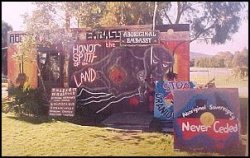
The Aboriginal Tent Embassy is a controversial semi-permanent assemblage claiming to represent the political rights of Australian Aborigines. It is made of a large group of activists, signs, and tents that reside on the lawn of Parliament House in Canberra, the Australian capitol. It is not considered an official embassy by the Australian government.
History
In 1972, the Tent Embassy was established in response to a federal ruling rejecting Aboriginal land rights. No Aborigines were involved in the decision, and Aborigines across the country were deeply disturbed by the ruling. Many protesters met on the lawn of the Parliament House, made up a list of demands, and refused to leave until their demands were addressed. Over thirty years later, they are still there. There have been a few minor violent confrontations when the government tried to force the Tent Embassy to disperse, but it has never gone away. Its staying power, despite its rickety, temporary architecture, has become an important symbol to many Aborigines.
When the 2000 Olympic Games came to Sydney, Aborigines set up a second Tent Embassy on the Olympic grounds. The peaceful demonstration became a part of the show, with many Olympic athletes giving offerings and prayers to the Aborigine ritual fires.
Issues
The Tent Embassy promotes Australian Aboriginal Sovereignty. Their demands included land rights and mineral rights to Aboriginal lands, legal and political control of certain sacred sites, and compensation for land stolen. Their demands have been consistently rebuffed.
The group describes itself as an embassy, a designation the Australian government objects to. The group claims to represent a displaced nation of peoples, unjustly occupied by the Australian government. The subject remains very controversial in Australian politics.
External links
- Aboriginal Tent Embassy: Icon or Eyesore? http://www.aph.gov.au/library/pubs/chron/1999-2000/2000chr03.htm